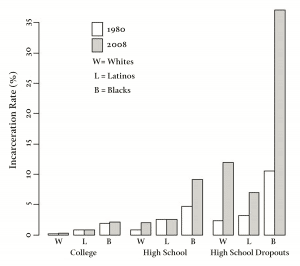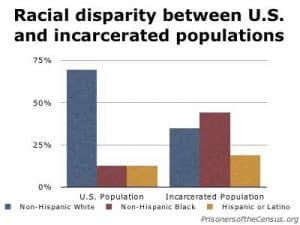[tps_header]
Did you know that the poorest half of the US owns only 2.5% of the country’s wealth? How much do you think the top 1% owns, then? Try 35% of the national wealth.
The Stanford Center for the Study of Poverty and Inequality published an article called “20 Facts About US Inequality that Everyone Should Know”. This facts are really 20 categories in which inequalities are raging in the country, from education to health care or even race (surprised?).
We all know the so-called “American Dream”, a delusion of an utopian version of democracy. The United States might once have been a land of opportunities, but it stands now as the richest and one of the most unequal country of all.
Let’s have a look at four of the categories at the core of the issue (Income and poverty, Health Care, Education and Incarceration) :
[/tps_header]
Income and Poverty
Income inequality refers to the extent to which income (revenue streams from wages, salaries, interests, dividends from shares of stock etc) is distributed in an uneven manner among a population.
(Figure 1: “Household and Family Income” – inequality.org)
The top 1% of America’s income earners have more than doubled their share of the nation’s income since the middle of the 20th century. Inequality in America is growing, pushing a small number of “lucky” people even further from the others. Indeed, before the 1980s, lower-income earners owned a far larger portion of total US income than they do today.
Norton and Sorapop Kiatpongsan published a study in 2014 in which they aimed at assessing perceptions of income inequality. They found out that the average American believes that the richest fifth own 59% of the national wealth and that the bottom 40% own 9%. The reality is strikingly different: the top 20% of US households own more than 84% of the total wealth.
Amongst the population, there is a category of people that has suffered from income inequalities far more than the others: American lowest-range workers. In fact, after taking inflation into account, they have seen little to no growth in their real wages in the last three decades. According to Pew Research, most Americans believe the economic system unfairly favours the wealthy. And republican hard-liners like Donald Trump are targeting this share of the population, the one feeling left behind by the economic system, to try to blame it on globalisation or immigration.
(Figure 2: “A look at pay at the top, the bottom, and in between” – Bureau of Labor Statistics)
Which brings us to our last part: economic inequalities seem to have fuelled the debate on migration, America’s eternal bone of contention. Indeed, many US citizens, especially in larger states close to the Mexican border, are reluctant to migration because they think lower-paid illegal workers would poach their jobs and drag down wages. Not only is this wrong (see “Let them in and let them earn” from The Economist, 29/08/15), but this fear is also perpetuating the circle of injustice and inequality.
Now, where do income inequalities really come from? Whether you are an economic student or not (I won’t hold it against you), this is simple to understand: the richest families in the country (we are talking about the 0.1%, even the 0.01%), have been piling assets since the 19th century. Their wealth, mostly coming from interests in savings and private incomes, has only been temporarily diminished by the First and Second World Wars. Since the 1980s, almost this exact same group of people has seen their revenues skyrocket, coming from extremely high-paid jobs. And this, of course, only makes the process of capital accumulation even easier (as Piketty pointed out, in “Le capital du XVIIIè au XXIè s).
Health Care
“If you want to get an idea of the gap between the world’s sickest and healthiest people, don’t fly to a faraway land. Just look around the United States.”
– Fourth, a series on what Harvard scholars are trying to identify and understand inequality, in seeking solutions to one of America’s most vexing problems.
Health inequality is deeply entrenched in America, linked with other social problems such as disparities in income, education, housing, race, gender and even geography. Inequality in health can be subdivided in three categories:
- disparities in health itself: rates of asthma, cancer, heart disease, diabetes, drug abuse, violence etc
- disparities in care: access to hospitals, skilled professionals, medical technology, essential medicine etc
- inequality in health insurance: the financial means to pay for the care needed in order to stay well.
These three problems require interlaced solutions. President Obama’s Patient Protection and Affordable Care Act (ACA) has taken huge steps in narrowing the gap in health insurance coverage, but those gains haven’t had a significant impact on the other two health care disparities, leaving diverse groups unequally healthy so far.
Disparities are built into the health care landscape, but it seems that life expectancy is increasing for African-Americans and the poor. Although stark disparities remain, the overall health picture is one of improvement. Still, the remain disparities are daunting: life expectancy, which depends on resident’s race and ethnicity, varies as much as 30 years between the richest and poorest US counties.
And what it worse, a study by the Brooklyn Institution found that the gap has widened considerably. This is a major reason why US life expectancy trails many peer nations: according to a 2014 report by the OECD (Organization for Economic Cooperation and Development), US life expectancy in 2012 was 78.7, 27th out of the group’s 34 industrialized democracies.
It is obvious that disparities of any kind mostly begin at birth for many African-Americans or the poor share of the population, but one would hope that the health care system would be part of the solution. Instead, what is found, over and over, is that not only does it not do that effectively, sometimes it makes disparities worse.
At the core of this poignant issue are, once again, the soaring costs of health care in America (heart bypass in the US cost $75,354 in average, compared to $42,130 in Australia, the second-highest amount). Evidently, when you live in a country where you have to choose between paying your medical bills or your rent, the ones that get evicted are not the top 1%.
Surprisingly, the US spends an average of $9,000 per person on health care, which translated to more than 17% of gross domestic product. (at least 50 percent more than any other country). However, plenty of other countries see much better outcomes in their citizen’s actual health overall.
We can only hope that the recent path towards universal health coverage will grant a better place in the life-expectancy scale for the US.
Ichiro Kawachi, John L Loeb and Frances Lehman of Public Health’s Department of Social and Behavioral Sciences:
“If you’re born a black man in, let’s say, New Orleans Parish, your average life expectancy is worse than the male average of countries that are much poorer than America.”
But Ichiro Kawachi also adds that
“It’s not only a question of racial disparities. At the root of it are unequal economic opportunities and unequal education.”
Education
What are the odds today of escaping a poverty-ridden lifestyle, despite inner intelligence and thrive to succeed in life? Not as many as we would like to think.
“The greatness of America is expressed in its commitment to liberty, as it has challenged the individual, and in its commitment to equality, as it has challenged us collectively”, says Joseph Gauld, the Founder of Hyde Schools.
He thinks that the US educational system has so far failed to accomplish the mission of equality, since it has pushed students to be evaluated on a single skill (academic proficiency) and thus aggravating economic or cultural inequalities in the children’s background. Hence, the ones that end up dropping out of school or cheating are more likely to come from lower cultural and economic backgrounds. Moreover, since education equals opportunity, the educational system plays a role in the tremendous wealth imbalance, because it unfortunately favours wealth. Studies have shown the SAT is directly tied to family income: students which families have a yearly income of $20,000 score on average 891, gradually rising up to students whose family earns $200,000 within a year, who score an average of 1142 (“SAT scores and family income” – The NY Times). Not surprisingly, amongst the students at the top 146 colleges, only 10% come from the bottom half of the population.
Although incomes play a big role in education inequalities, there are some other factors that should not be overlooked. “The position of US black students today is truly alarming” writes Roland Fryer, a black economics professor at Harvard University. Yes, race is a powerful factor too. Achievement gap between minorities and white Americans has been an unmet challenge for over half a century. Regarding segregation, in 2005, the number of Black students in White majority schools had fallen to levels lower than in 1968.
“Education must enable a man or woman to become more efficient, to achieve with increasing facility the legitimate goals of his or her life…the function of education, therefore, is to teach one to think intensively and to think critically”– Martin Luther King Jr, 1947.
At the time King wrote these words, black children were denied access to a quality education solely on the basis of race. The case “Brown vs the Board of Education” in 1954 marked history by creating an opportunity for African-Americans to reach new heights through an education system that was equitable.
However, fifty years after Brown, the achievement gap is widening. Though schools are not legally segregated, school performance is racially divided. “The Black-White Test Score Gap” is the name of the haunting comparison between achievements by white and black students. In California, 18% of high school students fail to graduate in four years. For African American students, the dropout rate is 30% and for Latino students it is 23%.
Therefore, what could be done to tighten the education gap between white students and racial minorities? Let’s focus on California, for example. The new Local Control Funding Formula ties funding to student achievement. Plus, the recent regulations on the funding system passed by the California State Board of Education will help parents and community decide how education dollars are spent and if they are indeed serving children with the greatest needs. Moreover, what students really seem to lack, coming from racial minorities, is a quality early childhood education. Thus, the state has been ensuring a foundation for later academic success for these students, in hoping to diminish the startling consequences linked to the lack of early childhood education: 25% more likely to drop out of school, 40% more likely to become a teen parent, 60% more likely to never attend college and 70% more likely to be arrested for a violent crime.
Incarceration
Which brings us to our last category, and one of the scariest. America’s prisons and jails have produced a new social group. A group of social outcasts who are joined by the shared experience of incarceration, crime, poverty, racial minority, and low education.
The most important social fact is the inequality in penal confinement, a profound institutionalized inequality that has renewed race and class disadvantage. It produces phenomenal rates of incarceration among young African American men with no more than a high school education.
(Figure 3: Percentage of Men Aged Twenty to Thirthy-Four in Prison or Jail, by Race/Ethnicity and Education, 1980 and 2008 – Bruce Western and Becky Pettit on mass incarceration)
Among young African American men with high school diplomas, about one in ten is in prison or jail. This number is even scarier for African Americans who have dropped out of high school: more than one in three. Most of the growth in incarceration rates in concentrated at the very bottom, among young men with very low levels of education. The ubiquity of penal confinement in the lives of young African American men with little schooling is historically novel, emerging only in the last decade.
(Figure 4: US Census and Bureau of Justice Statistics, Graph: Peter Wagner 2004).
However, this new reality is only half the story of understanding the significance of mass incarceration in America. The other half of the story concerns the effects of incarceration on social and economic inequality. Correctional experts have long understood that releasing incarcerated people to the streets without job training, an education, or money is the perfect formula for recidivism and re-incarceration. While the fact that people released from prison have difficulties finding employment is well-documented, there is much less information on the role that poverty and opportunity play in who ends up behind bars in the first place. The findings of the Bureau of Justice Statistics are as predictable as disturbing: the America prison system is bursting with people who have been shut out of the economy and who had neither a quality education nor access to good jobs. In 2014, incarcerated people had a median annual income which was 41% less than non-incarcerated people of similar ages.
(Figure 5: Median annual incomes for incarcerated people prior to incarceration and non-incarcerated people ages 27-42, in 2014 dollars, by race/ethnicity and gender).
Through the incarceration rate is now nearly eight times its historic average, the scale of punishment today gains it social force from its unequal distribution. And as an outcast group, the men and women in the US penal institution have little access to social mobility, therefore sustaining other inequalities as well.
Summing up !
Inequalities need to be America’s main concern, since they are the source of every deeply entrenched problem in the country. Indeed, guns and race, America’s birth defects, are both mostly triggered by inequalities. This is why politicians like Bernie Sanders address it as the top one priority. America was once a land of equal opportunities. Thus, since it never had kings or nobility, it might not be realising today that its elites are calcifying.
“We have no idea how unequal our society has become” – Nicholas Fitz for Scientific American.
















